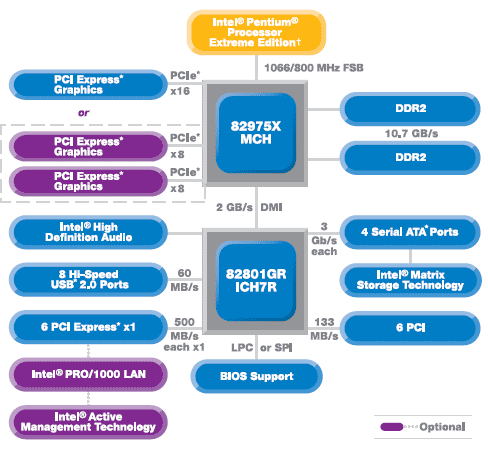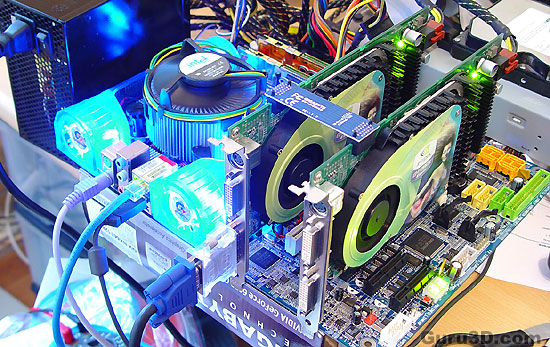Page 2
The features and Specs
The G1975X is of course based on Intel's new 975X Express chipset and was designed for Intels highest performance platforms. It does support the latest Intel dual-core processors. Another function we mentioned on the previous page already is tha fact that the Intel 975X Express Chipset enables support for multiple graphics cards. The chipset also has Intel Memory Pipeline Technology (Intel MPT), 8GB memory addressability to enable 64-bit computing, and hey now .. ECC memory support which is so expensive, none of us will ever buy it.
Gigabyte employs its usual deal of interlocked SATA ports. Accompanied by the ICH7R Southbridge it supports four SATA2 ports in varying RAID 0,1,5 and 10 selections which fall under Intel Matrix Storage Technology. Rather than add another set of SATA ports, Gigabyte chooses to include an ITE8211F IDE RAID controller that can put up up to two devices from the ATA133-compliant port, we'll show you the photo's later on. USB2.0 support emanates from the ICH7R but 3-port FireWire is added via a Texas Instruments chip.
Here's a small overview of the more important Intel's 975X features, courtesy of Intel:
| Features | Benefits |
| 1066-/800-MHz System Bus | Supports Intel® Pentium® processor Extreme Edition and Intel® Pentium® D processor to deliver higher performance for games and applications. |
| Intel® Memory Pipeline Technology | Enhanced memory pipelining that enables a higher utilization of each memory channel, accelerating data transfers between the processor and system memory, resulting in higher system performance. |
| Intel® High Definition Audio | Integrated audio support for new consumer electronic formats, increased audio quality, and multiple audio streaming capability for premium digital sound. |
| PCI Express* Interface | 16 lanes of PCI Express in the Memory Controller Hub (MCH) capable of delivering greater than 3.5 times the performance over the traditional AGP 8X interface, supporting the latest graphics cards for demanding games and applications. 6 PCI x1 lanes in the I/O controller hub support a broad array of I/O cards and applications. |
| PCI Express* configuration flexibility | 2 PCI Express controllers in the MCH enable either 1 x 16 or 2 x 8 operation for the 16 PCI Express lanes. |
| Intel® Matrix Storage Technology | Provides quicker access to digital photo, video, and business files with RAID 0, 5, and 10, and data protection against a hard drive failure with RAID 1, 5, and 10. |
| Serial ATA* (SATA) 3Gbps | High speed storage improves transfer rate for improved data access. |
| Dual-channel DDR2 Memory Support | Up to 10.7GB/s of bandwidth and 8GB addressability for faster system response. |
| Intel® Flex Memory Technology | Facilitates easier upgrades by allowing different memory sizes to be populated and remain in dual-channel mode. |

When you look at the i975X chipset you simply can't close your eyes to the Southbridge; it's the flagship ICH7R and, as such, identical to the one found on i955X motherboards. The differences really need to be found in the Northbridge chip. The wide-ranging memory support and internal pathway optimizations for reduced latency seem (at least what I believe) to be similar to the i955X, and also similar the i975X also supports the multitude of LGA775 CPUs available at present.
There is one big distinction though .. the i975X is guaranteed to support Intel's 65nm processors (Presler and Cedar Mill cores). Also intersting is the availibility of (look at image above) six PCI-express lanes that run over the southbridge. In theory we could connect four graphics cards to this system. I'll show you the layout of these slots later on in the photo shoot, opening up the way for multi-GPU solutions both in terms of extra display monitors (2D) and dual-graphics (3D) support.
And this feature specifically of course brings is towards NVIDIA SLI & ATI Crossfire.
Actually i975X isn't the first Intel chipset/motherboard to support multi-GPU rendering. Much like the Intel D955XBK motherboard it supports ATI's CrossFire technology, but not NVIDIA's SLI.
Since this platform has slots for 2 full PCI-Express graphics cards AND the mainboard included an actual SLI connector I was getting my hopes up that SLI would be supported and at the very least wanted to try this. I inserted two GeForce 6800 GT graphics cards which both where supported by Windows after the hardware installation. They installed fine yet as the mainboard manual slightly hints already .. it won't work in SLI mode. The ForceWare driver refuse to enable SLI functions so no-matter what you try or do .. it just won't work.
Why then does Gigabyte inserted a SLI bridge .. I'm really not sure other then perhaps they know something that I don't ? It might very well be that certain "Gigabyte" branded NVIDIA GeForce graphics cards WILL be supported. Or perhaps future ForceWare drivers will support this platform ? Who will say.
ATI's Crossfire however will work (the I975 chipset is actually certified for it) ... I ran out of time but I insert a Master and a Slave Crossfire card and for the brief few minutes I had left the Catalyst drivers noticed the cards properly and enabling Crossfire mode was allowed.
So there is immediate CrossFire compatibility but, as yet, no driver support to enable a couple of GeForce cards to run in dual GPU mode, and it's a dishonor that NVIDIA and Intel haven't been able to batter out a deal that would see SLI run on a non-NVIDIA motherboard.
So there you have it, officially Intel does not support SLI (yet), however, Crossfire is supported and the lack of SLI is probably more or less a matter of a lockout at the ForceWare driver level.
Who knows in the future we'll find some modified drivers eh ? If anyone succeeds .. let me know and we'll gladly miror them.

You've got the hardware connected properly, but for sure SLI will not work. What a pity.
